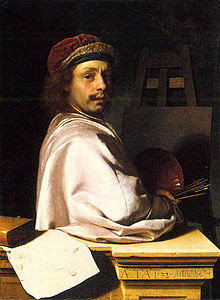Frans van Mieris the Elder
Frans van Mieris | |
|---|---|
 The Artist as Virtuoso at His Easel: Self Portrait, Aged 32 (1667) | |
| Born | Frans van Mieris 16 April 1635 |
| Died | 12 March 1681 (aged 45) Leiden, Dutch Republic |
| Nationality | Dutch |
| Known for | Painting |
| Movement | Baroque |
Frans van Mieris the Elder (16 April 1635 – 12 March 1681), was a
Biography

Frans was born and died in
He seldom chose panels of which the size exceeded 12 to 15 inches, and whenever his name is attached to a picture above that size it is reasonable to assign it to his son Willem or to some other imitator. Unlike Dou when he first left Rembrandt, or Jan Steen when he started on an independent career, Mieris never ventured to design figures as large as life. Characteristic of his art in its minute proportions is a shiny brightness and metallic polish.[2]

The subjects which he treated best are those in which he illustrated the habits or actions of the wealthier classes; but he sometimes succeeded in homely incidents and in portrait, and not infrequently he ventured on
It questionable whether Houbraken has accurately recorded this master's birthday. One of his best-known pieces, a party of ladies and gentlemen at an oyster luncheon, in the Hermitage at St Petersburg, bears the date of 1650. Celebrated alike for composition and finish, it would prove that Mieris had reached his prime at the age of fifteen. Another beautiful example, the "Doctor Feeling a Lady's Pulse" in the gallery of Vienna, is dated 1656; and Waagen, in one of his critical essays, justly observes that it is a remarkable production for a youth of twenty-one. In 1657 Mieris was married at Leiden in the presence of Jan Potheuck, a painter, and this is the earliest written record of his existence on which we can implicitly rely. Of the numerous panels by Mieris, at least twenty-nine (such as Young Woman Stringing Pearls) are dated—the latest being an allegory, long in the Ruhl collection at Cologne, illustrating what he considered the kindred vices of drinking, smoking and dicing, in the year 1680.[2]

Mieris had numerous and distinguished patrons. He received valuable commissions from
The pictures of all the generations of the Mieris family were successfully imitated by A. D. Snaphaan, who lived at Leipzig and was patronized by the court of Anhalt-Dessau. To those who would study his deceptive form of art a visit to the collection of Wörlitz near Dessau may afford instruction.[2]
Theft
In early June 2007,
References
- ^ a b (in Dutch) Frans van Mieris biography in De groote schouburgh der Nederlantsche konstschilders en schilderessen (1718) by Arnold Houbraken, courtesy of the Digital Library for Dutch Literature
- ^ a b c d e f One or more of the preceding sentences incorporates text from a publication now in the public domain: Chisholm, Hugh, ed. (1911). "Mieris". Encyclopædia Britannica. Vol. 18 (11th ed.). Cambridge University Press. p. 425.
- ^ Allegory with boy blowing bubbles - Rijksmuseum, Amsterdam "Allegorie op de vergankelijkheid - Rijksmuseum Amsterdam - National Museum for Art and History". Archived from the original on 2011-06-09. Retrieved 2009-10-30.
- ^ "Art Crime Alert: Masterwork Stolen in Australia", July 30, 2007, U.S. Federal Bureau of Investigation. Fetched from URL on 19 May 2011.
- ABC News Online, accessed 14 June 2007
